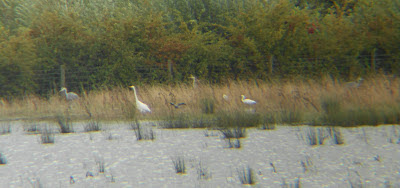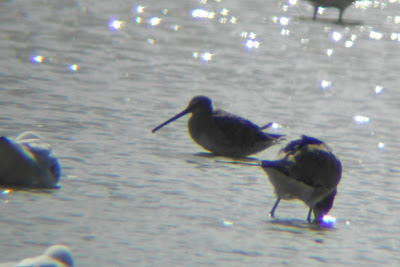28/08/12
Our annual late August visit to Slimbridge was held today, and it combined with the presence of a decent rarity. I had been keeping a fairly close eye on the bird reports from the @Slimbridge_Wild Twitter page and the WWT website, and i was quite dissapoined that the Wader flocks that usually build up at this time of year on the estury had not really materialised, combined to that the fact that high tide was just as the centre closes, i knew that esturine wader's might not be noted.
And i wasnt wrong!
Just starting on the way down i was checking twitter when a new tweet popped up, Spotted Crake and Long-Billed Dowitcher showing from South lake hide. Awsome, be there in 40 minuites!
We arrived to a rather full south lake hide, and i was informed that the Crake hadent shown, and the Dowitcher was hidden amongst the sleeping
Godwits, of which there was a 200 strong flock of!
We stayed in the hide for about 1 1/2 hours hoping the Crake would show or the Dowitcher would emerge. Eventually, the
LONG-BILLED DOWITCHER did wake up, and walk from behind a
Godwit, showing itself briefly before heading back to sleep.
On this, we decided to wander.
Wood Sandpiper has been abit of a bogey this year, and i havent caught up with one. However, one had been showing from the Robbie Garnett hide for a few days now, an easy tick and run, surely?
NO
Combined with the Crake, these two birds were the most stuborn birds of the whole day, and we spent hours looking for both!
We walked up via the Rushy, where i quickly spotted a female GARGANEY dabbling with the Teal. Briefly, it swam into the close bay in front of the hide, and i was treated to great views of this migrant duck as it swam around briefly, before swimming back with the rest of the Teal.
From here though, it briefly went downhill. We stopped off at the Robbie Garnett hide, and spend a good hour looking for the Wood sand, apparently it was frequenting a small 30ft stretch of the shore that was hidden by reeds from the hide!! Ahhhhhh.
We then moved into the Holden Tower, were a brief, distant flypast of 30 Dunlin was the only esturine wader activity of the day!
We dropped into both the Robbie Garnett (Still no Wood sand) and the Rushy (Garganey now at the back), where 2 PINTAIL were showing right at the back of the pool.
While walking through the 'Birds of a suspect origin' sections of the centre it became obvious that most of the birds from the Zeiss hide had been flushed while we were just heading over there!
We scanned the Lapwing flocks, and picked out a few RUFF and a GREENSHANK, most of which then landed on the South lake. Anyway, we continued our journey to the Zeiss, were i had my dinner that i had prepared, a nice Cheese and Ham Bagguette, lovely.
As expected there wasnt much birdlife here as much of it had been flushed, however, initially, 3 RUFF were grounded among the Lapwings.
But, just about when i was finishing my Bagguette, a further 4
RUFF flew in, giving us a total of 7 birds infront of us. A single
GREENSHANK was also here. Scanning through the flocks of Duck was quite uneventful, no Wigeon, no Pintail.
Thinking i might try my luck at the Crake again, and to now be able to get some photos of the Dowitcher as the sun had moved slightly away so hopefully the birds wouldnt be silouetted.
Well i'll just say what happened, another hour, another no sign of the Crake, and my worst nightmare was unfolding, the
Godwit flock was still sillouetted! But i though i cant leave without at least a record of the
Dowicther, which wasnt showing particularly well.
A very nice number of Waders were on the South lake, and it was great to be sifting through the large numbers of
Lapwing and
Black-Tailed Godwit's, picking up
RUFF'S,
GREENSHANKS 80c
Redshanks and
Green Sandpipers. and of cause, the
LONG-BILLED DOWITCHER, which was now feeding.
As i said, most of the wader flock (Including the area with the Dowitcher) were in strong sunlight which was bouncing off the water, and i could only get backlit shots of the birds.
Hoping the light would be better later in the day we left so that we could walk to Middle point, stopping at each hide on the way up. The Garganey had now dissapeared, and a longish stint in the Robbie Garnett one again revealed no Wood sand.
However, this Hawker sp Dragonfly was showing on reeds infront of the hide, another 'Odonta' (I believe thats how you spell it to add to the digi-scoped list!
We walked down the Holden Walkway to the Middle point, stopping halfway to view from a gap in the hedge where you could see some of the 'invisible shoreline' where the Wood Sand was. And amazingly, we could see the WOOD SANDPIPER! However distant, but still, i finally got it, about 4 hours after first trying to see it!
It was obvious there wasnt going to be any waders other than a few distant Curlew on the estury, however, i find that the Middle point 'hide' is a nice place to have a sit down, you really do think your miles away from civilisation, and , with it being a 'wall to wall' blue sky day, it was a nice place to just have a nice stop and wait.
We noticed abit of commotion over the dumbles as the Curlews and the Gulls 'got up', and i quickly scanned over there and saw a 'Buzzard' circling quite high up. After abit, i looked again, as i wasnt particularly certain over its ID. And by now, it had came closer and it wasnt just a Buzzard like shape now. I quickly noticed its tail looked strangely long, and its wings sightly odd, but i couldnt tell why. But the bird was still sillouetted.
I thought that the bird looked 'odd', so decided to call to 'get onto this Raptor'. By now though i had glimpsed a pale head, and called out MARSH HARRIER!. The bird then proceeded to circle above our heads, by which time i'd got the bird in my scope, and i enjoyed great views of a new species for me! Tick 1 off the 'Bogey List'
The bird, then slowly dropped lower as it flew past us, over towards the 100 acre, dropping down behind the tree line.
A very large Gull flock was developing on the mudflats to the north, however way to far away to ID, and 2 LITTLE EGRET's were also showing far to the north. However, we got lucky as another LITTLE EGRET had chosen to hunt the small pool just infront of the viewpoint.
2
PEREGRINE were flying, and perching around on the mudflats.
Moving up to the slightly higher viewpoint behind us on the Seawall, we scanned the fence lines, and i picked up 3
WHEATEAR, which is always a nice addition to the day list. I again looked to the north, and i picked up the
MARSH HARRIER hunting low over the reeds at the 100 acre area that you can see. A few more views were had as it moved back and forth over the reeds.
I wanted to have one last look for the Crake on the south lake, and to cut a long story short, the bird didnt show again untill after closing time, by which time we had arrived back home. The
LONG BILLED DOWITCHER was still showing and feeding, but slowly became less active.
The wader flock had grown further since we were last here, and the 230 Black-Tailed Godwits were joined by, 3 Greenshank, 80c Redshank, 3 Ruff, which was a nice little list.
Highlights for the day were:
LONG BILLED DOWITCHER
MARSH HARRIER
Wood Sandpiper
Garganey
2 Pintail
3 Little Egret
9 Green Sandpiper
1 Common Sandpiper
c80 Redshank
4 Greenshank
7+ Ruff
3 Wheatear
MB





















































